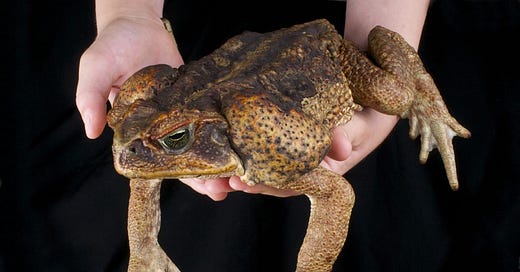Welcome to blog number 6 this week. Of the other 5, two were getting very long and are still unfinished, two were going nowhere (they started out great and then kinda petered out) and one got me down a rabbit hole so deep I never got past the first paragraph.
The rabbit hole I mentioned above resulted in another rabbit hole about invasive species, and not the ones you might be thinking of...
Let’s start with a definition: Invasive species are non-native (or alien) to the ecosystem under consideration and whose introduction causes or is likely to cause economic or environmental harm or harm to human health.
Not all non-native species are bad. Cattle were introduced to North America, as were lettuce and tomatoes, among other plants and they are considered beneficial That’s why the definition has the second part, “likely to cause…harm”.
In movie terms, a good non-native species would be Uncle Buck in the movie like “Uncle Buck”, while a bad non-native species would be just about any zombie movie.
Some invasive species we know about, like pine beetles in Western Canada, or murder hornets in western North America. I want to focus on some of the lesser known invasive species that are actually common place now.
Cane Toads
Possibly one of the most famous types of invasive species and probably the most widely studied of all the “introduced” species, with over 500 papers published. “Introduced species” is what it’s called when deliberately brought into a new environment. When it almost inevitably gets out of control it becomes a pest, much like the relative you invite for Christmas dinner who is great at first but after one too many eggnogs becomes overbearing, annoying and insists on drunkenly telling everyone all the embarrassing things that you did as a child.
Cane toads come from South and Central America. They were first introduced into the Caribbean in the 1840s to control the rat population (cane toads are large and eat anything that can fit in their mouths). They failed miserably. Despite that they were introduced to Puerto Rico to control sugar beetles which were destroying the sugar cane plants. This they did so well that by the 1930s they were promoted as ideal when trying to control pest in agriculture.
They have been introduced into several areas in the world, where they have reduced pests in sugar cane fields as well as mosquito populations, in some but have had no effect in others. Then there’s Australia.
Introduced into Australia in 1935 they failed to control the cane beetles but were successful at severely impacting the local biodiversity, even leading to local extinction of a marsupial cat, the Northern Quoll.
Rabbit Hole
Cane toads secrete a toxin when threatened. It’s mildly hallucinogenic and is classed in the same category as heroin and LSD. Eating cane toads has been linked to deaths in dogs, humans and most reptiles, however opossums, meat ants and saw shelled turtles seem to be able to eat them with impunity. Australian water rats have learned to eat cane toads by turning them over, onto their backs, removing the gallbladder, where the poison is, and then eating the internal organs. Crows have also been observed doing the same thing.
End Rabbit Hole
Speaking of Australia and cats.
Cats

Free range, outdoor, and feral cats are considered an invasive species in Australia and in most of the world because of the damage they do to natural species like birds. In the US alone, outdoor cats are blamed for the killing of over one billion birds. Cats have one of the most varied diets and are known to be able to eat over 2,000 different animals. The best control is to spay or neuter your cat and keep them indoors.
Cats are considered to be the most significant invasive alien mammalian predator in the world.
Dogs

Lest you think I’m being unfair, dogs (after rats and pigs) are also considered a destructive invasive species. Dogs have been shown to not just kill wildlife but to spread diseases, such as rabies and distemper to native populations. One of the most damaging things that loose/wild dogs do is to displace native wildlife. Studies have shown that just the scent of dogs can cause wildlife to move away to new areas, and in many cases reducing the amount of food available through competition. Interestingly this doesn’t seem to occur as much with wolves or coyotes.
Let’s end this with the invasive species that started me going down this rabbit hole.
Tumbleweeds.
Yup, tumbleweeds; that staple of the North American west and westerns is not native to the continent. The first tumble weed appeared in South Dakota in the 1870s. It’s thought that a shipment of flaxseed from Russia was contaminated with tumbleweed seeds (mainly Salsola tragus). Known as the Russian thistle, or windwitch, it really loved the hot dry conditions of the North American west and spread quickly. It has a tolerance for salty conditions and for sand but is highly adaptive so it can be found all through the Americas (north, central and south) and in dry and wet conditions including along beaches.
Young plants are edible but as it gets older it becomes woody, bitter and spiny (somewhat like me). As the plant gets older it dries out and becomes brittle, detaches from its root system, and becomes the stereotypical tumbleweed. These plants are often inedible by all but the most hardy animals, like goats. Goats can pretty much eat anything, I think. These older plants present a serious fire risk and have been known to trap people in homes or vehicles when blown up against buildings or autos (the spines will interlock so they have to be cut apart to be removed).
So the next time you are watching a western and a tumbleweed drifts through the scene, if it takes place before the 1870s feel free to write the producers and let them know they screwed up. I’m never going to watch The Good, The Bad and The Ugly again, just in case.
Thanks for reading, I’m going back to the other five I started this week and see if I can revive any of them.
Cheers.




